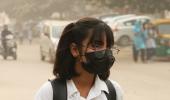'When I have to go outside, I wear a mask.'
'Air purifiers are there, but for this kind of pollution levels, they are not that effective.'
'Also, the room that you are in, has to be well insulated. And most of the time, in India, the rooms are not insulated.'

Dr Siddhartha Mandal is the lead investigator of an eye-opening study, published in October in BMJ Open Diabetes Research & Care, that staggeringly established a link, epidemiologically, between exposure to air pollution (particularly PM 2.5 particles) and the increased risk of type 2 diabetes in India.
A senior researcher at the Centre for Chronic Disease Control, New Delhi, who did a degree in statistics from IIT-Kanpur, and a PhD from University of North Carolina at Chapel Hill, Dr Mandal and his seven co-authors have been studying, since 2010, an adult cohort of 12,064 participants, in New Delhi and Chennai, for the 'associations between ambient PM2.5 levels and fasting plasma glucose, glycosylated hemoglobin (HbA1c) and incident type 2 diabetes mellitus'.
Dr Mandal spoke to Vaihayasi Pande Daniel/Rediff.com about his headline-hitting research.
The first of a two-part interview:

In this study you are looking at populations, both in Chennai, and Delhi. As far as this risk of diabetes goes, obviously, it would be higher in Delhi, because the city is far more polluted, right?
Not necessarily. Let's say you take Chennai with annual averages of around 30 to 40 micrograms (per metre cube of air). Then if you look at Delhi, it's around 80 to 100.
But if you look at the dose response curve, if you keep increasing your dose (of pollution), how much response you're getting, and that usually is steeper in the earlier parts. Then it plateaus.
If let's say you if you're comparing two people, or two populations, one of which/whom is exposed to 30 micrograms and other is exposed to 40 micrograms. The difference you will get, it's probably going to be higher.
But if you let's say you're comparing a population which is at 100 micrograms per metre cube, and then you look at another population, which is at 110, the additional risks are not going to be that much higher, because you're already at a bad situation at 100 micrograms.
When we look at Delhi and Chennai, the effects were surprisingly similar in terms of the effect.
We have put everything together, and if we had data from all across the country, that would have given us a wider range. We need populations at all different kinds of pollution levels, otherwise, you cannot do a comparison.
That's why we had to do a comparison within Chennai. And a separate comparison within Delhi. Incidentally they came out to be similar. If we have national level data, then we would be able to do this for the entire country and see what is happening at what level.
And I'm sure after this report was published in The Guardian you must have been inundated with calls and people wanting to speak to you?
Yes.
Especially, I think, the timing also is important. The paper just came out in October. Now November has come and everybody's talking about pollution. So, there has been a lot of attention to the findings of the paper.
But, I mean, we did a hypertension paper earlier in 2020. Within the same cohort. And we showed that pollution was also increasing the risk of hypertension, by quite a lot. That did not get so much attention just because it came out in August.
It is important to know that it is not a one-time problem. It's not a problem only in November. I think people don't usually realise that.
It's all year-round problem?
Yes, it's a chronic thing. It's not like you're just getting a solution for two days. And that is affecting you. It's going on throughout the year. Now because we see the haze and all, that's when you realise it -- when you see the pollution.
The particles are so fine. In say February or March, you are not able to see it. But it's still there. And if you look at 30 to 40 micrograms, you will probably not be able to see it see with your naked eye. It's still there, and it's affecting throughout the year. It's an annual average exposure or two year average exposure, that's going to affect.

You live in Delhi. What are the measures that you yourself take against air pollution?
I stay inside most of the time and when I have to go outside, I wear a mask.
Air purifiers are there, but for this kind of pollution levels, they are not that effective. Also, the room that you are in, has to be well insulated. And most of the time, in India, the rooms are not insulated.
Do air purifiers work? Or is an air conditioner as good an air purifier?
No, air purifiers do work with HEP A filters. But they have a limit. If you expose a purifier to 500-600 micrograms per meter cube, you cannot expect it to work that effectively and you have to change the filters maybe every week. So that is not a feasible solution.
It has to be a well-insulated room so that your base level is somewhere around 50 or 30, then it can be brought down to let's say 5 micrograms. That it can do.

An air purifier is an expensive solution also, especially all year round?
Yes, expensive. That is for an indoor air pollution problem.
While outside you're exposed to much more -- traffic and people burning biomass and all. That's an entirely different situation. Air purifiers cannot be very effective in those cases.

Supposing you're travelling in traffic, but you're in an air-conditioned car or an Uber, are you relatively better off?
Yes. There's an AC button, which allows for the air inside to be circulated. There's another option where you take fresh air from outside into the car. You should opt for the one where air inside should be circulated and don't take air in from outside.
I mean, there's still some exposure, but at least you're (somewhat better off) -- so put your windows up, put your AC on, and it should circulate the air inside.
Probably these kinds of studies were not done in places like let's say, America, or London, because they don't have the kind of air pollution problem we have. So that's why this study originated in India?
There have been a lot of studies in the US and in all the European countries. And it doesn't matter whether we have extremely high levels (compared to them). You can see some of these effects even at very low levels -- at say 10 micrograms.
Multiple studies have been done in the US, which show the effects at these lower levels, with regard to cardiovascular outcomes, and mortality also.
In London when the Great Smog of 1952 was there, those were extremely high level. But for a shorter period of time, and steps were taken to bring it down to the levels that are there right now. But even at both levels, there's been a lot of research on multiple chronic disease outcomes.
 IMAGE: Dr Siddhartha Mandal. Photograph: Kind courtesy Dr Siddhartha Mandal
IMAGE: Dr Siddhartha Mandal. Photograph: Kind courtesy Dr Siddhartha MandalBut not necessarily diabetes?
Diabetes does not have very strong associations at low levels. But even at 20 to 30 micrograms, people have shown effects in China or Taiwan.
It is more particular to India, because we have genetic predisposition to diabetes?
There are interactive effects. You have both air pollution and diet factors. And the physiology of Indians, which even if you have a low BMI, you still have a high fat content -- those things interact with each other, and then it gives them a higher risk.
It's early days, but this study would be of interest to places with higher levels of pollution in South Africa, even Italy, China?
Yes, it would be relevant to middle income countries (with pollution issues).
We have only looked at Delhi and Chennai. There's a whole range of tier-two cities, which have similar kinds of problems. And there's not many studies on those places.
Feature Presentation: Ashish Narsale/Rediff.com











 © 2025
© 2025